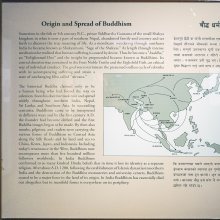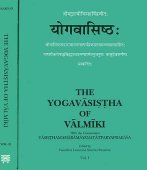Ceasing, Cease, Ceased: 1 definition
Introduction:
Ceasing means something in Hinduism, Sanskrit. If you want to know the exact meaning, history, etymology or English translation of this term then check out the descriptions on this page. Add your comment or reference to a book if you want to contribute to this summary article.
Images (photo gallery)
In Hinduism
Yoga (school of philosophy)
Source: ORA: Amanaska (king of all yogas): A Critical Edition and Annotated Translation by Jason BirchThe Ceasing of sleep (as a result of Yogic practice) can be denoted by the Sanskrit term Abhāva, according to the Amanaska Yoga treatise dealing with meditation, absorption, yogic powers and liberation.—Accordingly, as Īśvara says to Vāmadeva: “[...] [Now], I shall define the nature of that highest, mind-free absorption which arises for those devoted to constant practice. [...] By means of an absorption for two Kalās, with the moving about of Kuṇḍalinī, there arises in a flash a single trembling of [the Yogin's] mind. By means of an absorption of four Kalās, his sleep ceases. In his heart, the Yogin observes a point of fiery light (nidrā-abhāva) like a spark. [...]”.

Yoga is originally considered a branch of Hindu philosophy (astika), but both ancient and modern Yoga combine the physical, mental and spiritual. Yoga teaches various physical techniques also known as āsanas (postures), used for various purposes (eg., meditation, contemplation, relaxation).
See also (Relevant definitions)
Query error!
Full-text (+977): Uparati, Uparata, Uparamana, Vishranta, Uparama, Avarati, Virata, Vyapeta, Nivartaka, Nivritta, Ajanani, Prashanta, Vinivritta, Upavritta, Vicchinna, Vigata, Samnivritta, Nivritti, Vyupashama, Sannivritta.
Relevant text
Search found 446 books and stories containing Ceasing, Cease, Ceased, Ceases; (plurals include: Ceasings, Ceases, Ceaseds, Ceaseses). You can also click to the full overview containing English textual excerpts. Below are direct links for the most relevant articles:
Introducing Buddhist Abhidhamma (by Kyaw Min, U)
Chapter 7 - Vipassana Meditation < [Part 2 - Meditation]
Chapter 4 - Mind And Matter < [Part 1 - Abhidhamma]
Chapter 6 - Right Understanding < [Part 2 - Meditation]
Pointing to Dhamma (by Ven. Khantipalo Bhikkhu)
Sermon 23: From Endeavor Wisdom Springs
Sermon 24: Certainly the Dhamma Protects the Dhamma-Practitioner
Ahara as depicted in the Pancanikaya (by Le Chanh)
3.5. Ahara and Five Aggregates < [Chapter 3 - Ahara and specific teachings of the Buddha]
2. Cultivation of food of contact < [Chapter 6 - Cultivation of four kinds of Ahara]
7. Bhuta-sutta (“Become or Come to be”) < [Appendix 1 - Buddha's teachings on Ahara (Pali texts and English translations)]
Visuddhimagga (the pah of purification) (by Ñāṇamoli Bhikkhu)
Insight (3): Knowledge of Appearance as Terror < [Chapter XXI - Purification by Knowledge and Vision of the Way]
The Material Septad < [Chapter XX - Purification by Knowledge and Vision of the Path and the Not-path]
The Fourth Jhāna < [Chapter IV - The Earth Kasiṇa (Pathavī-kasiṇa-niddesa)]
Patthanuddesa Dipani (by Mahathera Ledi Sayadaw)
Abhidhamma in Daily Life (by Nina Van Gorkom)
Related products



